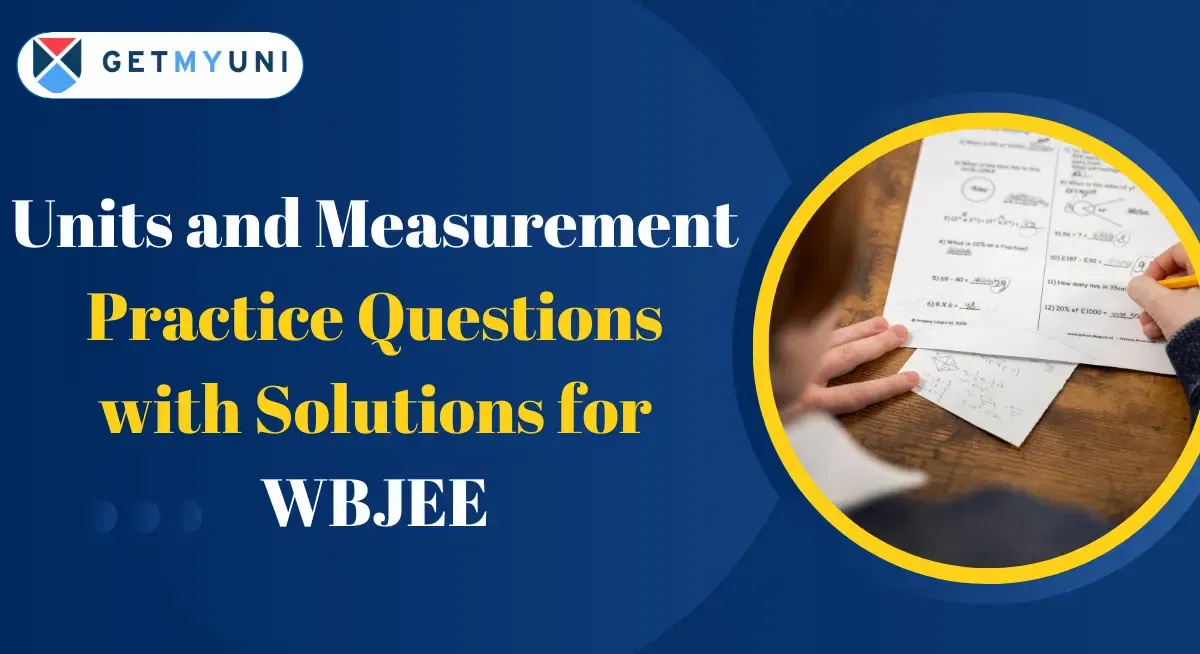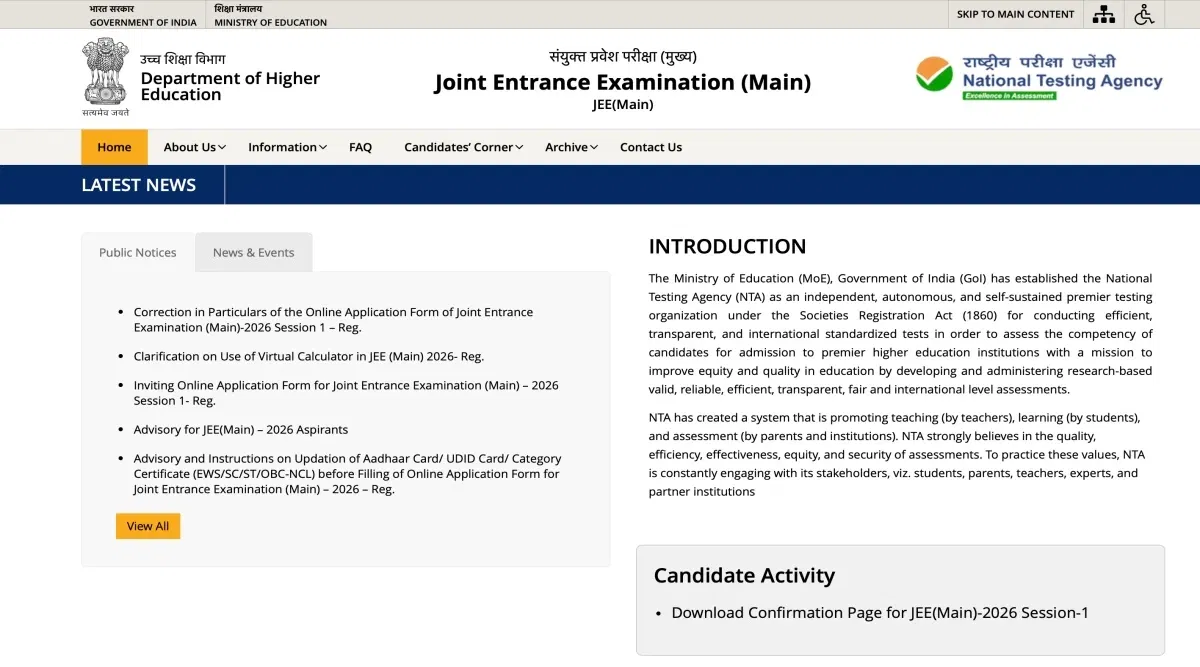Solving the WBJEE 2025 units and measurement practice questions can help students achieve a score between 160 to 180. They must learn the basics, practice dimensional analysis tricks and solve previous papers regular for a good preparation.
Table of Contents
A regular look at the Units and Measurement practice questions with solutions can help aspirants gain a good score in the WBJEE exam, carrying a 2% weightage in the physics section. This chapter lays the foundation for the physics WBJEE syllabus 2025.
Once the students understand this chapter from the WBJEE physics syllabus 2025 properly, they can easily solve the complex equations in various physics topics such as mechanics, thermodynamics, and electromagnetism. Thus, it is advised to solve the previous sample problems regularly and use dimensional analysis tricks.
The WBJEE 2025 exam is scheduled for Apr 27, 2025. Candidates can find the practice questions with solutions from the article below.
Importance of Units and Measurement in WBJEE 2025
The WBJEE syllabus 2025 is vast. The Physics section particularly requires a detailed understanding of the basic concepts like Units and Measurement. This chapter in WBJEE is very important because of the various reasons:
Foundation for all Calculations in Physics
The units and measurements chapter in WBJEE 2025 contains the essential formulas and calculations required to solve physics problems. These formulas calculate force, energy, electric field, etc.
Dimensions Analysis
A clear understanding of the Units and Measurement chapter allows the candidates to verify the equations, derive new relations, and eliminate the wrong options in MCQs. It helps in solving problems quickly without long calculations.
Recurring Concept
Various physics concepts require dimensional analysis or appropriate SI unit application. Thus, these questions from this chapter appear directly or indirectly in the WBJEE 2025.
If candidates know the Units and measurement chapter completely, they can avoid mistakes.
Scoring Chapter in WBJEE 2025
The questions from units and measurements asked in exams are usually straightforward. Practising this chapter can help candidates score good marks easily and enhance their overall rank.
Also Read: WBJEE Important Questions 2025
Practice Questions for Units and Measurement in WBJEE 2025
WBJEE 2025 Units and Measurement practice questions with solutions can help candidates master the chapter and score high on the exam. Here are the important WBJEE Physics questions 2025 with solutions for candidates' reference, along with their solutions:
Q. The velocity of a particle (v) at an instant t is given by v = at + b2. The dimension of b is:
- L
- LT-1
- LT-2
- LT-3
Answer: LT-3
Q. In an experiment, the length of an object is measured to be 6.50 cm. This measured value can be written as 0.0650 m. The number of significant figures on 0.0650 m is:
- 3
- 4
- 5
- 6
Answer: 3. Measurement of the object = 6.50cm
Number of significant figures = 3
Now, when the measured value is converted from one unit to another unit, the number of significant figures remains the same in both cases. The number of significant figures in 0.0650 m is 3.
Q. Which of the following quantities has the dimension of length? (h is Planck's constant, m is the mass of the electron, and c is the velocity of light)
- hc/m
- h/mc2
- h2/mc2
- h/mc
Answer: h/mc
To determine which quantity has the dimension of length, we need to analyse the dimensions of each option provided.
We have: h as Planck's constant, m as the mass of the electron c as the velocity of light. First, we need to recall the dimensions of these constants:
Planck's constant (h) has the dimension of action, which is energy multiplied by time: [h] = [E].[T]
Where [E] is the dimension of energy and [T] is the dimension of time. The dimension of energy (E) is given by [E] = [M][L] 2 /[T] 2, where [M] is mass, [L] is length, and [T] is time. - The dimension of mass (m) is simply [M]. - The dimension of the velocity of light () is [c] = [L]/[T].
Also Read: How can you Score 100+ Marks in WBJEE 2025?
Q. The correct dimensional formula for impulse is given by:
- ML2T-2
- MLT-1
- M2t-1
- MLT-1
Answer: MLT-1
Impulse, I = force (F) x small time interval I = ma x t [F = ma] I = [M] [LT -2 ] x [T] I = [MLT -1 ].
Hence, the correct dimensional formula for impulse is given by [MLT -1 ].
Q. The Entropy (S) of a black hole can be written as S = ???? kBA, where kB is the Boltzmann constant and A is the area of the black hole. The ???? has a dimension of:
- L2
- ML2L-1
- L2
- Dimensionaless
Answer: L2.
Given, S = ????kBA where, the dimensional formula of S = [M -1 L 2 T -2 K -1 ]
Dimensional formula of kB = [M -1 L 2 T -2 K -1 ]
Dimensional formula of A = [L 2 ]
Thus, [M -1 L 2 T -2 K -1 ] = ????[M -1 z T-2 K-1][L 2 ] ???? = [L-2]
Q. The density of the material of a cube can be estimated by measuring its mass and the length of one of its sides. If the maximum error in the measurement of mass and length are 0.3% and 0.2% respectively, the maximum error in the estimation of the density of the cube is approximately:
- 1.1%
- 0.5%
- 0.9%
- 0.7%
Answer: 0.9%
Q. The frequency v of the radiation emitted by an atom when an electron jumps from one orbit to another is given by v = kδE, where k is a constant and δE is the change in energy level due to the transition. Then, the dimension of k is:
- [ML2T-2]
- The same dimension of an angular momentum
- [ML2T-1]
- [M-1 L-2 T]
Answer: [M-1 L-2 T]
Q. The dimension of the universal constant of gravitation, G, is:
- [ML2T-1]
- [M-1 L3 T-2]
- [M-1 L2 T-2]
- [ML3 T-2]
Answer: [M-1 L3 T-2]
Q. From dimensional analysis, the Rydberg constant can be expressed in terms of electric charge (e), mass (m) and Planck constant (h) as [Consider 1/4πε0 = 1 unit]
- h2/me2
- me4/h2
- m2/e4/h2
- me2/h2
Answer: me2/h2
Q. The velocity of a particle (v) at an instant t is given by v = at + bt 2. The dimension of b is:
- L
- LT-1
- LT-2
- LT-3
Answer: LT-3
Q. The Power radiated from an accelerated charged particle is given by P ∝ (pa)m/cn, where q is the charge, a is the acceleration of the particle, and c is the speed of light in a vacuum. From dimensional analysis, the values of and respectively, are:
- m = 2, n = 2
- m = 2, n = 3
- m = 3, n = 2
- m = 0, n = 1
Answer: m = 2, n = 3
Also Read: What is a Good Score in WBJEE 2025?
WBJEE 2025 Syllabus: Key Concepts in Units and Measurement
The Units and Measurements chapter comprises several key concepts that students preparing for the WBJEE 2025 exam must be familiar with. Here is the syllabus for the WBJEE 2025 units and measurements chapter:
Physical Quantities
Physical quantities are measurable and can be expressed numerically, such as Length (L), Mass (M), Time (T), etc. The types of Physical Quantities include Fundamental Quantities and Derivative Quantities. Fundamental qualities cannot be broken down, such as Length, Mass, and Time. Derivative Quantities are formed with the combination of fundamental quantities, such as Speed (distance/time) (LT-1).
Units
Unit is known as the standard measurement of a physical quantity, such as meter for length, Kilogram for Mass, etc. There are 2 systems of units - SI and CGS.
|
Unit Systems |
Length |
Mass |
Time |
|
SI |
meter (m) |
kilogram (kg) |
second (s) |
|
CGS |
centimetre (cm) |
gram (g) |
second (s) |
Quick conversion examples
|
Quantity |
SI Unit |
CGS Unit |
Conversion |
|
Force |
1 N |
= 105 dyne |
1 N = 10⁵ dyne |
|
Work |
1 J |
= 107 erg |
1 J = 107 erg |
|
Pressure |
1 Pa |
= 10 dyne/cm2 |
1 Pa = 10 dyne/cm2 |
Dimensions
The dimensions are used for expressing the physical quantities with formulas such as Force = mass x acceleration = (M) x (L T-2) = (M L T-2 )
The dimension analysis is used for various purposes such as:
- Verifying equations
Example - Check if v2 = u2 + 2as is correct dimensionally
- Derive new relationships
In case candidates forgot or don't know any formula, they can derive it using the dimensions
- Unit Conversion
They can convert the units using the dimensional methods.
Measurement of Length, Mass, and Time
The commonly used tools for measuring length, mass, and time are vernier callipers, Beam Balance, Stopwatch, etc.
|
Quantity |
Instrument |
|
Length |
Vernier Calipers, Screw Gauge |
|
Mass |
Beam balance, Electronic Balance |
|
Time |
Stopwatch, Atomic Clocks |
Accuracy, Precision & Errors
Candidates can analyse the closeness of their measurement to the true value for accuracy and check how close the repeated measurements are to each other.
The types of errors include Systematic errors and Random errors.
|
Error Type |
Description |
|
Systematic Errors |
The same error occurs every time (e.g. fault in the instrument) |
|
Random Errors |
Varied results in every reading |
Significant Figures
The significant figures show the accuracy and reliability of the measurement. The significant figures include all non-zero digits, zeros between digits, and trailing zeros (if decimal point). Leading zeros are not counted as significant figures.
For Example:
- 0.00560 - there are 3 significant figures
- 3000 - 1 significant figure (unless it's written as 3.000 x 103)
Combination Errors
The errors are when quantities are combined using add, subtract, multiply, or divide.
|
Operations |
Rule |
|
Add/subtract |
Add absolute errors |
|
Multiply/Divide |
Add percentage (relative) error |
Important Formulas From WBJEE Units and Measurements
The important formulae used in units and measurement are:
|
Concept |
Formula |
|
Absolute Error |
ΔA = |
|
Relative Error |
ΔA / A |
|
Percentage Error |
(ΔA / A) × 100 |
|
Significant Figures Rules |
Add/Subtract - Least decimal places |
|
Dimensional formula |
[M^a L^b T^c] for physical quantity |
Quick WBJEE 2025 Preparation Tips for Scoring High in Units and Measurement
Preparation for the Units and Measurement chapter requires a proper strategy and planning. Here are the tips which candidates can use for the preparation of this chapter and score high in WBJEE 2025:
- Learn SI Units and Dimensions: To learn SI units and Dimensional formulas of physical quantities such as force, work, time, etc, make a chart and keep revising it regularly.
- Understand the Types of Errors: For a strong WBJEE preparation 2025, candidates must have their basics cleared to differentiate between absolute, relative, and percentage errors. Keep practising the error formulas with multiple variables.
- Practice Dimensional Analysis Tricks: Candidates must use dimensional methods to check formulas as a quick way to solve the MCQs and match the column questions. Practice a lot for converting units such as km/hr to m/s, etc.
- Learn the Use of Significant Figures: Candidates must practice and learn the rules for addition, subtraction, multiplication, and division. Make sure they don't lose marks for rounding off errors.
- Solve the WBJEE Previous Year's Papers: Collect WBJEE question papers for previous years and analyse the pattern. Also, candidates must figure out how they can manage their time during the exam and reduce the exam pressure.
- Don't Skip NCERT: The NCERT class 11 physics book is very important to prepare for this chapter. Candidates will get properly structured examples and practice questions. They can begin preparation with the NCERT and then practice with advanced books such as D. C. Pandey, etc.
- Practice Consistently: Divide the time properly and give 20-30 minutes a week for WBJEE Physics Chapter Units and Measurement. Candidates can also use mock tests for better preparation.
Also Read: WBJEE Important Topics with High-Weightage 2025
Units and Measurement is a small and simple chapter, but it has high importance in the WBJEE 2025 exam. The chapter is not only scoring but also useful in solving various physics problems. Regular practice and revision can help you master this chapter. Candidates must learn all the formulas and practice their correct implementation for WBJEE 2025.







![University of Calcutta, [UC] Kolkata](https://media.getmyuni.com/azure/college-image/small/university-of-calcutta-uc-kolkata.jpg)



![Heritage Institute of Technology, [HITK] Kolkata](https://media.getmyuni.com/azure/college-image/small/heritage-institute-of-technology-hitk-kolkata.jpg)





























POST YOUR COMMENT